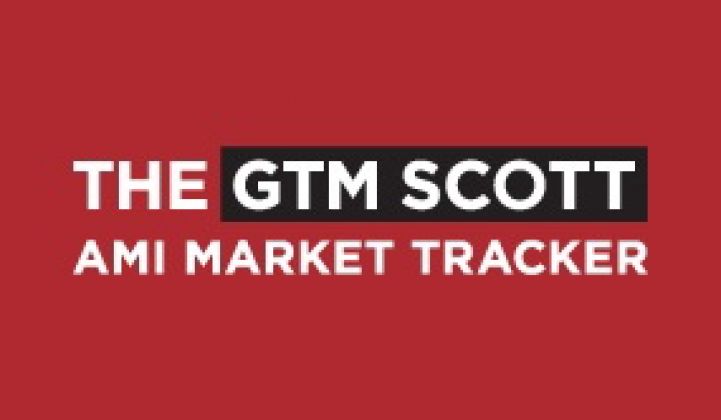As smart metering deployments continue to grow, one of the distinguishing characteristics of projects has been the choice of AMI communications provider. Shipment information from the Q1 GTM Scott AMI Market Tracker shows Silver Spring Networks, Itron and Sensus dominating the AMI communications market. From the perspective of meter hardware, the market is controlled primarily by Landis+Gyr, GE, Itron, Sensus and Elster.
As noted in our previous report, The Smart Grid in Europe: 2012-2016, the radial structure of the North American electrical grid, as well as less stringent wireless communications standards, have made radio frequency (RF) communications the preferred choice in North America, in contrast to Europe, where power line carrier (PLC) is more ubiquitous. It comes as no surprise that the three vendors that have shipped the greatest number of communication cards, both cumulatively and in Q1 2012, have relied on wireless RF technology, with Silver Spring and Itron utilizing a mesh topology over public spectrum and Sensus employing a point-to-multipoint architecture on a licensed spectrum. PLC-based solutions have gained limited traction in the United States, with Aclara and Landis+Gyr accounting for the majority of the limited market, though Duke Energy had maintained a contract with Echelon until October 2011.
Cellular: A Supplement, Not Necessarily a Substitute
In January, Silver Spring announced its Gen-4 chipset would be capable of integrating both cellular and RF mesh communications. Just one month later, Itron announced plans to acquire cellular communication provider SmartSynch for $100 million. The strategic moves of both companies, along with decreased carrier rates, indicate that cellular is already becoming a viable supplement to RF, particularly for utilities with a combination of urban and rural service territories.
Look for Sensus to potentially expand its cellular offering to AMI, given that cellular currently serves as a communications medium for its distribution automation network. There shouldn’t be too much pressure, considering the company just announced it would be increasing the available spectrum on its private FlexNet AMI network. Don’t count out Trilliant either -- the Redwood City, California-based company has had a cellular offering for polyphase meters since 2007 and more recently won a contract with British Gas in 2010.
Shifting Capex to Opex
While moving to a hosted cellular network eliminates or displaces upfront capital investment for utilities, public utility commissions are generally more hesitant to approve rate increases designed to recover operating costs vs. infrastructure costs. As long as these trends persist, it will be difficult for a managed cellular network to totally replace utility-owned RF networks.
End-to-End Solutions vs. Communications Only
Itron’s large share of the communications market comes as no surprise, given that it is one of the few companies with an end-to-end smart meter offering. Aside from producing meter hardware and communications cards, Itron also offers one of the most widely used meter data management platforms. Although Landis+Gyr’s share of the communication market is smaller than Itron’s, the company is poised to compete with its recent acquisition of meter data management company Ecologic Analytics. Landis+Gyr has also partnered with communications providers including Silver Spring, Aclara, and Trilliant as a hardware provider, so the success of these AMI communications vendors directly contributes to that of Landis+Gyr (as well as Silver Spring’s other majority meter supplier, GE).
Conversely, Silver Spring is the only vendor with a sizeable market share whose primary products do not extend beyond communications. While still operating at a net loss, the company has decreased losses year-over-year since 2009. Q1 2012 revenue is up about $9 million from the previous year. GTM Research has recorded just under 12 million shipments shipments throughout North America, though the company only picked up one new major North American customer in 2012 (Progress Energy).
VCs, IPOs and Acquisitions
Given a recent slew of acquisitions by power grid giants Siemens, ABB, Schneider Electric and GE, it is likely that we’ll see consolidation extend to AMI as well. Both GE and ABB already have a stake in Trilliant from a $106 million round of financing in 2010 which also included VC firms VantagePoint Capital Partners and Investor Growth Capital. Earlier this year, reports indicated Sensus had retained Credit Suisse to help look for potential buyers, while more recently, Elster has been in talks with London buyout firm Melrose PLC. Meanwhile, Siemens' recent acquisition of Brazilian meter maker Senergy will give the company a foothold in Brazil, which will be essential in avoiding the country’s costly import tariffs. (This isn’t the first time Siemens has entered the metering game -- the company owned a stake in Landis+Gyr prior to its acquisition by Australia’s Bayard Capital in 2004 and subsequent acquisition by Toshiba in 2011.) Amidst all of the M&A activity, Silver Spring is still awaiting a public offering. After Ambient Corporation’s reverse stock split in 2011, Silver Spring would be the second communications provider to be publicly traded on one of the major exchanges in the past two years.



